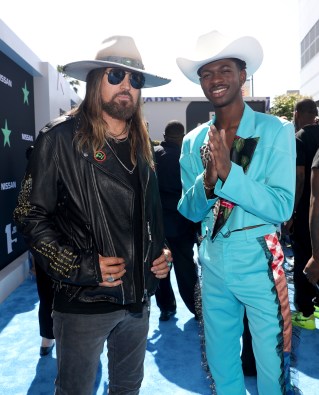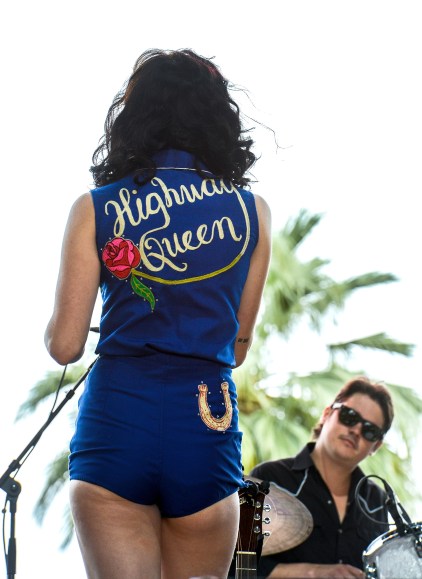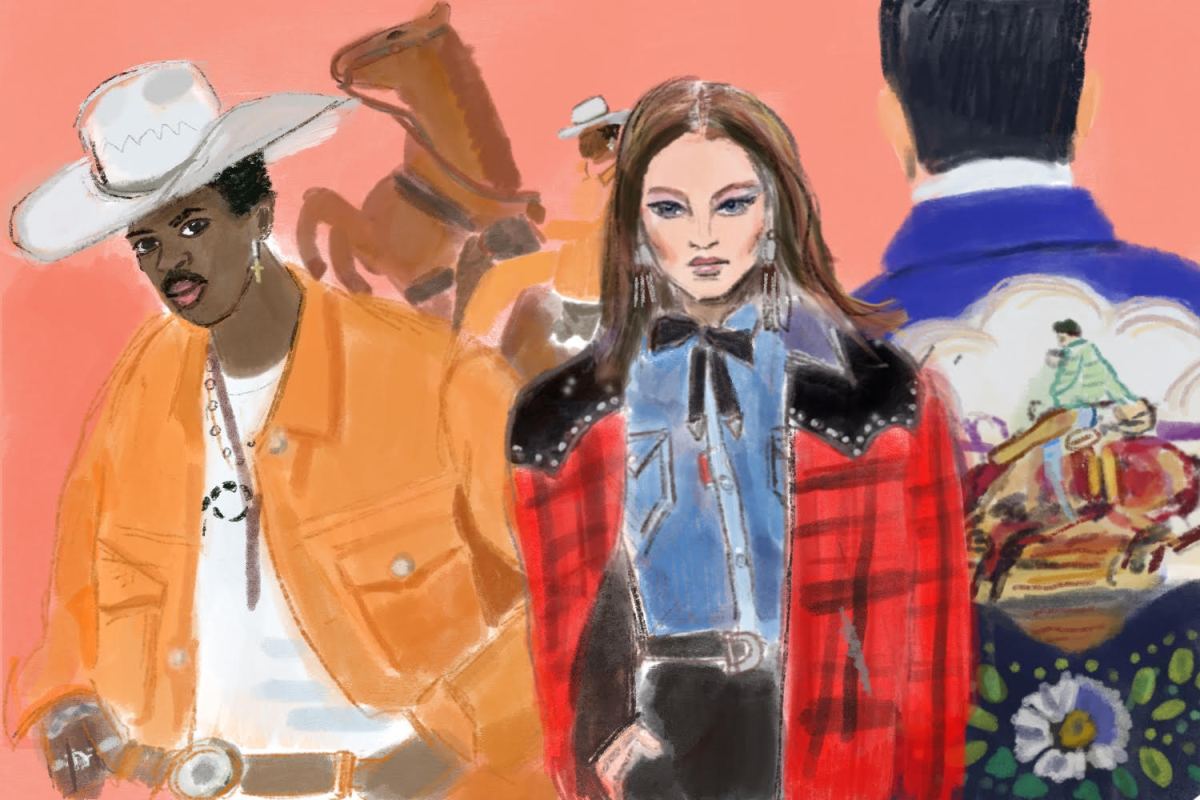If I had to choose one moment when country music became cool again, it would be April 26, 2017, a little bit before midnight, EST. That was when a tall brunette named Nikki Lane appeared on Conan O’Brien’s stage and performed a song called “Jackpot.” The song was terrific — lively and catchy, with just enough huskiness in Lane’s voice to give it an edge. But just as striking as the music was the look: the band all dressed in classic western stagewear — yoked shirts, cowboy hats and bolo ties — and Lane wore a white suit covered in rhinestones and colorful chainstitch embroidery that matched the song’s gambling motifs, with dice, gold coins one-armed bandits.
What was this glamorous and flamboyant sartorial vision? My father being from Texas, I’d grown up listening to country and western music, especially western swing acts like Bob Wills, Commander Cody and Asleep at the Wheel. And as a fashion writer I was familiar with the work of Nudie Cohn, the Hollywood tailor largely responsible for creating the genre of the outrageously studded-and-stitched western Suit. But Nudie was dead 20 years, and his most iconic suits — Hank Williams’s musical notes, Porter Wagoner’s wagon train and Gram Parson’s notorious pills-weed-and-poppies drug suit — were behind glass at the Country Music Hall of Fame in Nashville.
Nikki Lane’s jackpot suit, like her music, was fresh but traditional, with songwriting reminiscent of Merle Haggard and Loretta Lynn but with an updated sound that could hold its own with garage rockers like King Tuff or The Black Keys. Suddenly, with one song and one suit, country felt fresh again, liberated from decades of camo-cap-wearing huntin’ and fishin’ good ol’ boys and their left coast boho Coachella cowgirl sisters in turquoise, peasant tops and stetsons. A new wave of incredible young designers and tailors bringing new ideas to this long-dormant and sadly neglected American sartorial art form were given a new exposure.
Nobody knows this better than Jerry Lee Atwood, owner of Indianapolis-based Union Western Clothing and designer and tailor of the Nikki Lane “Jackpot” suit that first transfixed me.
“For a while musicians wanted to be more relatable,” Atwood says. “But now I think they’re bringing that glitzy showbiz look back to the working man.”

About 20 years ago, while working in a coffee shop, Atwood began doing small hand embroidery projects during slow hours. A customer saw him and gave him a book about the history of western wear, which brought back images he’d remembered from his father’s collection of country albums. In a personal twist right out of a country song, Atwood threw himself into his work after a divorce, teaching himself tailoring, pattern drafting and everything else needed to build a western suit from scratch.
“Putting your nose to the grindstone and focusing on your work is a good distraction from the things that aren’t going great in your life,” he says.
In 2017 things took off for Atwood when the stylist for rapper and singer Post Malone contacted him through Instagram, resulting in a series of elaborate chain-stitch suits which Malone wore in countless public appearances. Atwood was soon receiving regular commissions for non-country artists like Paloma Faith and Lily Allen, the latter of whom recently wore a pink Union Western suit embroidered with the London Underground map and several English icons, like the NHS logo and a pint of lager.
Atwood’s sartorial crossover success dovetailed neatly with a similar country-curious phenomenon happening in pop music, with artists like the masked club cowboy Orville Peck and the rapper Lil Nas X using classic country sounds and images in new contexts. Atwood made the suit Lil Nas X wears in the video for “Old Town Road,” the hip hop country crossover hit that generated controversy after Billboard removed it from its country charts. The suit was built to meet a deadline for the video over one frantic weekend in Atwood’s workshop.
“We understood the importance of this project,” says Atwood. “There’s something really important about this song and this moment, this crossover of country and hip hop. So we knew that this suit had to happen.”
While Atwood works out of the Midwest, the home of modern western wear, like country music itself, is Nashville, Tennessee. Nashville is, perhaps surprisingly, a major fashion industry hub, with local organizations like the Nashville Fashion Alliance — who report that the city has the highest per-capita number of independent fashion brands outside of New York and Los Angeles — offering resources to new brands, designers, and producers. In addition to many mainstream-style designers like Amanda Valentine, Black by Maria Silver, Cavanagh Baker, and Jaime and the Jones, there are at least half a dozen western tailors and designers working independently in the city, and for five years now, the Nashville Boogie festival celebrating mid-century Americana at the Opryland resort has featured a runway show in which artists show off their latest creations.

The local living link to the western wear glory days of the ’50s and ’60s is Manuel Cuevas, formerly Nudie Cohen’s head tailor and the proprietor of his own Nashville label, Manuel Couture, since 1975. The highly decorated and revered Cuevas continues to make his classic one-of-a-kind western suits in his workshop with a team of assistants, running an apprenticeship program that teaches young visionaries the fundamentals of things like embroidery and setting rhinestones. Rather than retiring, Cuevas has taken a privileged place as the godfather of western stagewear, ensuring that the skills he perfected in the Nudie studio will be passed on to the next generation.
Ashlyn Evans, one of the youngest designers on the scene, started work as an intern for Manuel before being hired as an assistant designer for a year. She now makes her own western suits for country superstars like Margo Price, who commissioned a red double-breasted suit with embroidered cactuses and cannabis leaves on the legs. She describes her work as “traditional with a modern twist.” Evans, who went to college for textile design, has her own innovations in the field: she uses an iPad and apple pencil to sketch out her embroidery, and she has plans to incorporate techniques like screenprinting into the arsenal of the western tailor.
“Western wear,” she tells InsideHook, “like country music, is telling a story with very vivid imagery. Musicians should have a stage presence that’s more than jeans and a T-shirt.”
That’s not to say that it’s only musicians — every designer I spoke with said that custom suits for weddings were their second biggest commissions, with new couples eager to hire these sartorial storytellers to provide a visual background narrative on their big day.
Maria Bangsgaard Køster, who makes western clothing under the label North Country Maiden, is another protege of Cuevas. Originally from Denmark, Køster was — unlike most Danes — obsessed with traditional American country music since she was a little girl.
“I was a real nerd,” she confesses. “I got totally caught up in it. And then I decided that I wanted to learn a handcraft. I was a musician back home and would write and really get into storytelling and I think that’s why I’m so attracted to these western suits — because they tell a story. That’s my thing more than anything: it’s working with a client and figuring out how to tell the story they have and express that through the garment.”
Køster’s particular love is the stage wear of the 1940s — the less-decorated, simpler, Americana look originally made famous by the likes of “Rodeo Ben,” the Polish-born tailor who, among many other things, created the signature cut of the Wrangler jean.
“We’re all fighting for the same cause,” she says, referring to her fellow tailors, “which is ‘don’t forget country and western music and tradition.’”
But tradition is only one side of the coin. What’s so exciting about the new generation of western wear designers are the ways in which they’re making their own, brand new marks on the genre. In Austin, Texas, for example, the design studio Ft. Lonesome, founded by Kathie Sever, has bought and painstakingly restored several original chainstitch embroidery machines, heavy, hulking task-specific machines, some nearly a century old, irreplaceable and often with new replacement parts unavailable. Because of these original, authentic machines, the studio boasts some of the most detailed and well-executed embroidery in the field, producing beautiful and elaborate work-of-art pieces that lean toward desert imagery and psychedelic colorways that resonate well with Austin’s own outlaw-hippy niche in the country-music pantheon.

Ellie Lahey, another designer based in Nashville but originally from New Orleans, sells a line of vintage western shirts onto which she embroiders playful designs like a T-Rex in a cowboy hat under the brand name Ellie Monster. She thinks of those simple easy-to-wear items as a kind of gateway to western wear for the typical consumer. Then she hits you with the strange stuff.
“It’s kind of pretentious,” she says, “but I’ve taken to saying that I’m ‘neo-traditional’ western wear. I’ve got a lot of the traditional elements but I take it to a weird place.”
Some of her more uncanny designs include a jacket made from a dollar-store deadstock tapestry of a lion and a set of fuzzy chaps that look like freshly-skinned muppet.
“Western wear is traditionally a little bit out there,” she explains. And, like mainstream fashion, it cycles. The bro country of the 2000s, she explains, was a reaction to 90s styles like the WWE-style printed lightning bolt shirts of Brooks and Dunn.
“It kind of goes back and forth,” she says. “People forget how ridiculous it was and so they start moving back in that direction.”
Most of the designers seem to agree: country music — and the clothes that go with it — is bouncing back from a somewhat paradoxical mode that pairs dressing down in jeans and flannel with highly produced, glossy music. Younger artists, like Nikki Lane, Midland, Margo Price and the Avett Brothers, are coming at it from the opposite direction: embracing glam and retro looks but with a rawer, roots-oriented sound.
“I might get in trouble for saying this,” says Koster, “but a lot of country music right now is pop music. I can’t relate to that. I’ve never taken my flip flops and gone to a back road with a six pack in my truck. What’s coming back now is outlaw country — it’s the new rock and roll. There’s a big hunger for instrumental music, for traditional, handcrafted music.”
To what extent the revival of western suits for performers will bleed down into what the guy on the street is wearing remains to be seen, but the dedication of these designers to keeping these old crafts alive while finding new expressions and innovations beyond what anybody’s done with them before suggests that this is more than a flash in the pan. And it heralds, along with the new voices within country music and those outside of it finding their ways in, an opportunity for a fresh appreciation of a long-faded thread of quintessentially American art. And the list of new designers working with elements of western wear continues to grow: RoseCut Clothing, Rangerstitch, Fables By Barrie, Riley Reed, Jukebox Mama, Chain Gang LA and more. Anyone who wants to buy a western suit or shirt is now faced with an abundance of choices.
“Country music is cool again,” says Atwood, explaining the interest in the work he’s done for Nikki Lane and Lil Nas X. “A new generation is getting excited about it. A lot of musicians I work with are making a stand and saying we’re sick of being ignored; we’re not rednecks, we don’t carry guns, we don’t chew tobacco and drink beer.”
He pauses.
“Well, they all drink beer.”
This article was featured in the InsideHook newsletter. Sign up now.
























